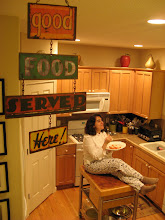I spent a lot of time thinking of a recipe that would be worthy of number 200. I knew it had to be big. Huge. Irresistible. Better than chocolate, even. And if there's any one thing that's better than chocolate, it's lemon. Nothing makes the taste buds feel alive like lemon. And now, dear reader, for the two-hundredth recipe…Drumroll please…May I present to you Frozen Meyer Lemon Mousse!

"I'm obsessed with lemons," I mused between bites of the mousse. To which my husband replied, "Yeah, anyone who's read the first 199 recipes would know."
Frozen Meyer Lemon Mousse
Printable Recipe
1 cup freshly squeezed Meyer lemon juice
Grated zest of 2 Meyer lemons
¾ cup sugar
4 large egg yolks
2 cups heavy cream
Combine the lemon juice and lemon zest in a small saucepan. Bring to a boil and simmer for 2 to 3 minutes, or until fragrant. Strain through a fine mesh sieve. Return the lemon juice to the pan and add the sugar. Bring to a boil and simmer until an instant-read thermometer registers 230˚F. When the sugar syrup is nearly ready, start whipping the egg yolks in a mixer fitted with a whip attachment. With the motor running on high, add the hot sugar syrup in a thin stream. Continue to whip on high until light and fluffy and cooled to room temperature. Whip the cream to soft peaks. Stir 1/3 of the cream into the yolk mixture, then fold in the remaining cream. Divide the mixture among 8 acetate-lined individual cake rings on a parchment-lined baking tray. Freeze for 4 to 6 hours, or until solid.
To unmold, transfer the frozen mousses to dessert plates. Slide off the cake rings and peel away the acetate.
Serves 8. This light and refreshing dessert is super puckery and not for the faint of tart. Good any time of year, but especially in the winter when citrus is in season. You will need about 6 large Meyer lemons for this recipe. If you don't have cake rings, simply make and serve the mousse in ramekins. Serve with lightly sweetened whipped cream, if desired.

















